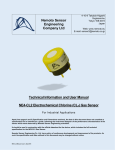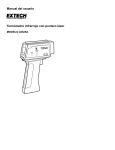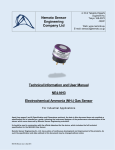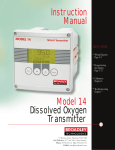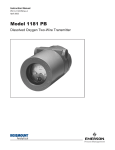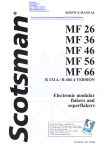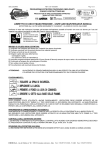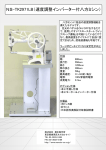Download Characterisation Document for Nemoto NAP
Transcript
USER MANUAL & CHARACTERISATION DATA NAP-505 Electrochemical Carbon Monoxide Gas Sensor Head Office: N.E.T. Srl Via A. Manzoni, 19 – 20010 Pogliano Milanese, Milan, ITALY Tel: (+39) 02 935 44190 Fax: (+39) 02 935 40347 WEB: www.nemototech.com E-MAIL: [email protected] NAP505-CD.doc, issue 3, April 2004 INTRODUCTION Nemoto & Co. Ltd was established in 1941 and continues to develop unique technologies for the Safety, Security and Health markets. Using our unique experience of fine chemical preparation and printing, we were able to enter the gas sensor market in 1979 with a range of high-quality hot-wire type sensors (pellistors). Nemoto is now one of the World’s leading manufacturers of chemical sensors and has so far delivered over 30-million devices to the market. As a result of three-years’ development at our Tokyo R&D centre, we released our first electrochemical gas sensors in 2000. The NAP-505 Gas Sensor is a new, low–cost 3 Electrode Electrochemical cell designed for the detection and measurement of carbon monoxide in the range 0-1000ppm, in domestic carbon monoxide detectors, fire detectors and air quality monitors. The NAP-505 easily meets the requirements of all international performance standards (UL2034, EN50291 and CSA22.2) without the use of electronic compensation. To date, high performance 3-electrode gas sensors have been mainly used in industrial applications due to their high cost of manufacture. By using our experience of design for manufacture and our high volume production facilities in Japan and China, we have successfully reduced the cost of the NAP-505 significantly whilst being able to maintain the highest levels of performance. This characterisation document does not constitute a specification but is intended as a guide, informing the instrument designer of the performance characteristics of the sensor which were observed by Nemoto Environmental Technology's Engineers. It should be read in conjunction with Technical Information Sheet DS-N-NAP505, which includes the full technical specification for the NAP-505 Gas Sensor. NAP505-CD.doc, issue 3, April 2004 - page 2 of 16 - PRINCIPLES OF OPERATION The NAP505 consists of 3 porous noble metal electrodes separated by an acidic aqueous electrolyte, housed within a plastic (PPO) enclosure. Gas enters the cell via a gas phase diffusion barrier (capillary) and a charcoal based filter that removes unwanted gases which might interfere with the sensors performance or give a false signal. An electrolyte reservoir ensures an excess of electrolyte is available at all times, and the sensor is vented to ensure that the internal and external pressure of the sensor is in equilibrium. In operation, gas enters the cell via the capillary and filter, and comes into contact with the ‘working’ electrode. Any carbon monoxide present undergoes the following (oxidation) reaction: CO + 2H2O → CO2 + 4H+ +4eThe CO2 generated vents away from the cell via the capillary, whilst the hydrogen ions (H+) migrate into the electrolyte within the cell. The electrons (e-) generated at the working electrode are collected by the external circuit via a metal strip in contact with it, in the form of a small (nA) electric current. The reaction at the working electrode is balanced by a reciprocal (reduction) reaction at the ‘counter’ electrode, using Oxygen from the surrounding atmosphere. O2 + 4H+ + 4e- → 2H2O The electrons consumed in this reaction are supplied by the external circuit via a metal strip in contact with the counter electrode. NAP505-CD.doc, issue 3, April 2004 - page 3 of 16 - Thus water is consumed whilst Hydrogen ions are generated at the working electrode, whilst the water is re-created and hydrogen ions are consumed at the counter electrode. At the same time, the reaction at the working electrode generates electrons, whilst the reaction at the counter electrode consumes electrons. By connecting the working and counter electrodes together via a special circuit, flow of electrons between the two electrodes is measured as a nA level current signal proportional to the carbon monoxide concentration. The ‘reference’ electrode maintains the healthy operation of the cell. It is surrounded by electrolyte, sees no gas and no current is allowed to be drawn from it. Its electrochemical potential hence always remains constant at a level known as the “rest air potential” and this is used to regulate the potential of the working electrode, regardless of the current it is generating during operation. The use of a reference electrode in this way (i.e. three-electrode operation) helps to extend the working range of the sensor, improves linearity and results in a number of performance benefits compared with similar sensors working with 2electrodes only. NAP505-CD.doc, issue 3, April 2004 - page 4 of 16 - FEATURES Electrochemical gas sensors have the following superiority to conventional semiconductor type and hotwire type gas sensors. • • • • • • • • Linear output in proportion to gas concentration High reproducibility Highly gas specific Unaffected by humidity Stable output for long periods Low power consumption because no heater is used (can be battery operated) Small and lightweight (can be used in portable devices) No mechanical structure so highly resistant to shocks and vibrations. NAP-505 has been developed from our accumulation of technologies in production of hot-wire type gas sensors, long research experience into catalysts, fine printing, and assembling of sensors. The NAP-505 is small and less-expensive, but has high sensitivity, long life, and leak-free performance even under severe operating conditions. Small-size NAP 505 is one of the smallest electrochemical sensors in the world to accommodate the design and manufacture of smaller gas detection products and allowing space for additional features. Air vent The electrolyte used for chemical sensors is very hygroscopic, i.e. it has affinity for water, and its volume varies depending on ambient temperature and humidity. This variation causes pressure inside the sensor to rise and fall. In the worst case the electrolyte may leak out of the sensor and damage the circuitry around it. To prevent this, the NAP-505 combines small size with an air vent capability. This maintains equilibrium between internal and external pressures and allows the sensor to be used in any orientation and under high temperature and humidity conditions. Solderable Conventional electrochemical sensors can not be soldered directly to pins because the rapid temperature increase causes thermal deformation of the plastic housing and subsequent leakage of electrolyte. The NAP-505 uses a unique electrode pin and socket design to dissipate heat and minimize the affect of high temperature. This simplifies the assembling process as the NAP-505 can be soldered directly to the PCB. NAP505-CD.doc, issue 3, April 2004 - page 5 of 16 - PERFORMANCE DATA 1) Linearity Linearity of NAP-505 (using basic operating circuit) 1 0.9 0.8 Output voltage (V) 0.7 0.6 0.5 0.4 0.3 0.2 0.1 0 0 500 1000 1500 2000 2500 CO gas concentration (ppm) NAP505-CD.doc, issue 3, April 2004 - page 6 of 16 - 2) Uncompensated Temperature Dependence: The following graph illustrates the typical effect of temperature on the output signal of the NAP-505, for a sensor calibrated at 20oC NAP-505 Temperature Dependence 140 120 % Original Output 100 80 60 40 20 0 -30 -20 -10 0 10 20 30 40 50 60 o Temperature ( C) NAP505-CD.doc, issue 3, April 2004 - page 7 of 16 - 3) Cross Sensitivities: The following table gives cross sensitivity information for a variety of commonly encountered gases. The selectivity of the NAP-505 is has been designed to comply with relevant standards such as EN50291, TUV standards and UL2034. Test gas Carbon monoxide Hydrogen Methane Iso-butane Carbon dioxide Sulfur dioxide Hydrogen sulfide Nitrogen monoxide Nitrogen dioxide Ammonia Ethyl acetate Heptane Ethanol HMDS (Silicone) Gas Concentration Tested (ppm) 100 500 5000 2500 5000 25 10 30 30 100 200 500 2000 10 Typical carbon-monoxide reading (ppm) Equivalent 100 200 0 0 0 0 0 0 < 10 0 0 0 < 30 (30 min Exposure) 0 (40 min exposure) NAP505-CD.doc, issue 3, April 2004 - page 8 of 16 - 4) Response Characteristics The following are plots of responses and recovery times for exposures to carbon monoxide at various concentrations: NAP-505 EN50291 5000ppm CO test (using basic operating circuit) 2.5 CO:5000ppm(15min.) test Output Voltage (V) 2 1.5 1 0.5 After 60 min. CO:50ppm test No.1 No.2 No.3 No.4 No.5 No.6 No.7 No.8 No.9 No.10 No.11 No.12 No.13 No.14 No.15 No.16 No.17 No.18 No.19 No.20 0 Sampling Time NAP505-CD.doc, issue 3, April 2004 - page 9 of 16 - 5) Stability, Environmental and Ruggedness The NAP-505 has been tested extensively to ensure that it can survive harsh environments and rough treatment, both in storage and during operation without failure or undue performance effects. A selection of the tests, with results, are outlined below: TEST Storage at High Temperature: Sensor stored at 50oC, 40%RH for 1000 hours. Output signal tested against original at STP following storage Storage at High Temperature/Humidity: Sensor stored at 50oC, 90%RH for 1000 hours. Output signal tested against original at STP following storage. Storage at Low Temperature: Sensor stored at -20oC, for 1000 hours. Output signal tested against original at STP following storage Storage at Low Humidity: Sensor stored at 25oC, <20%RH for 1000 hours. Output signal tested against original at STP following storage. Cool/Heat Cycle: -20oC, for 30 minutes, +50oC for 30 minutes 10 cycles Shock Test: Sensor dropped onto concrete floor from 1m height 5 drops RESULTING OUTPUT DRIFT < +/- 15% < +/- 10% < +/- 5% < +/- 10% < +/- 10% < +/- 5% NAP505-CD.doc, issue 3, April 2004 - page 10 of 16 - 6) Long-Term Drift Characteristics Zero Stability of NAP-505 (20oC) 500 Output Current (nA) 250 0 -250 -500 0 50 100 150 200 250 300 350 400 450 Time (days) Span Stability of NAP-505 (20oC) 50 Output per ppm CO (nA) 40 30 20 10 0 0 50 100 150 200 250 300 350 400 450 Time (days) NAP505-CD.doc, issue 3, April 2004 - page 11 of 16 - DEFINITIONS Base-line / Base-line shift Base line means the output level in clean air. The output current value at 20oC would be less than 250nA, but this tends to increase as the ambient temperature rises more than 30oC. The base-line shift means this variation of the output level, i.e. a maximum of 500nA would be put out at 50oC. This baseline shift should be taken into account to optimise overall accuracy. In this manual, the output values are calculated to be equivalent to CO gas concentrations. Gas sensitivity / Output signals Using the NAP-505, 40 ± 10nA is generated at 1ppm of CO gas. For instance, the generated current value will be about 8µA at 200ppm of CO gas (200ppm x 40nA). This generated current is generally recorded as a voltage produced by a Current – Voltage converting circuit. In our recommended circuit, as the conversion is done through a resistor of 10 KΩ. Response time (t90) This is the time taken to reach to 90% of the maximum output value in clean air. Repeatability This is the maximum variation of output signals when tests are repeated under the same measuring conditions (temperature, humidity, gas concentration etc.). The repeatability of NAP-505 is ± 2%, and this means that all of the test results would fall in the range of 98% ∼ 102%. Temperature dependence All electrochemical sensors are affected by changes in the ambient temperature and the output increases as the ambient temperature rises. This is caused by the rate of oxidation reaction on the surface of the catalyst, the dispersibility of the gas in the capillary, and the thermal affects on the mobility of ions in the electrolyte. This temperature dependency can be compensated relatively easily by using a NTC thermistor. NAP505-CD.doc, issue 3, April 2004 - page 12 of 16 - NOTES FOR CIRCUIT DESIGN 1) Basic operational circuit 0.1μF -V 0.1μF 4 8 counter 10kΩ 2 3 TH1 TH 16kΩ 0.1μF 1μF +V -V 4 8 0.1μF 3 Output Voltare 6 OP97 + 7 1 2 - 10Ω 6 OP97 7 1 Reference 15kΩ Working + NAP-505 - This circuit uses OP97 operational amplifier, that is easily obtainable and relatively low power. The temperature dependency of NAP-505 is compensated by NTC thermistor that has 3435K of B constant made by Ishizuka Denshi. Thus the output accuracy can be within ± 10% in the range of 10oC ∼ 50oC. Any thermistor with a B-constant around 3500K and resistance value (R25) of 10 KΩ can be used. 10Ω 0.1μF +V TH:NTC Thermistor R 25 =10kΩ B=3435k 103AT(Ishizuka Electronic Corp.) 2) Low power consumption circuit For general operational circuits, operational amplifiers such as OP97 used in our recommended circuit or classical OP07 can be used without problems. However for battery-operated circuits for portable devices, lower power consuming operational amplifiers are required. For example, the NJM4250 works at as low as 0.1 mA (max) with a supply voltage of ± 1 V ∼ ± 18 V. For simpler circuits with single power supply, battery-operation with 2 ∼ 3 V is possible and OP90 (20µAmax) or the like can be used. For a longer battery life, a pulsed operation may be utilised, e.g. 2 minute-off after 30-second operation, in order to save battery power consumption. 4 8 counter 2 Reference 6 7 1 3 + Working FET 4 8 V Output Voltare 6 7 1 + 2 3 - NAP-505 - When using an electrochemical sensor in cycled operation, transient signals may be seen just after power on and power off. Under normal operation 1 ∼ 2 minutes would be required for output stabilization. To eliminate this effect it is necessary to maintain a short-circuit between the working electrode (W) and the reference electrode (R) when the power supply is off. In this example the short-circuit is maintained using a FET so that the short is automatically broken during the power supply is on. Using this approach, the output is stabilized within 10 seconds after the power on. Sampling the output signal just before the power off enables accurate measurement data whilst saving battery power consumption. NAP505-CD.doc, issue 3, April 2004 - page 13 of 16 - 3) Battery operation 0.1μF 4 8 counter 10kΩ 2 3 TH1 TH 16kΩ 10kΩ 4 8 6 + 2 OP90 Output Voltage 7 1 3 - 10Ω 0.1μF 91kΩ +V 1μF This ensures a linear signal across the full measurement range. However if strict measurement results are not required in the range less than 50ppm, this virtual zero may not be needed. 6 OP90 7 1 Reference 15kΩ Working + NAP-505 - When exposed to CO gas, the potential of the counter electrode will need to move negative in respect to the working electrode. When a single power source (i.e. battery or D.C.) is used, it is necessary to maintain a virtual zero above 0V to allow optimal electrochemical performance. In this case, we recommend that this is between 0.2~0.5V. 0.1μF TH:NTC Thermistor R 25 =10kΩ B=3435k 103AT(Ishizuka Electronic Corp.) +V Characteristics of Single Power Circuits (using single power operational amplifiers) 250 Output Voltage (mV) 200 150 100 50 0 0 100 200 300 400 500 600 CO Concentration (ppm) Zero = 0V Zero = 0.5V 4) Self-diagnostic system For many applications, it is necessary to automatically identify critical sensor failure and in particular open and short circuit conditions. Nemoto has developed a patented electrical method suitable for battery and mains voltage operation. If this is required, please contact Nemoto and we will be happy to provide further details subject to a non-disclosure agreement. NAP505-CD.doc, issue 3, April 2004 - page 14 of 16 - NOTES 1) Long-term drift of gas sensitivity All electrochemical gas sensors lose sensitivity over time due to small changes on the surface of the working electrode, reducing its oxidation capability. To reduce this, the NAP-505 uses a newly developed electrode catalyst that will not deteriorate by more than 5% / year. Typically, these changes are limited to less than 5% but we recommend that this deterioration should be taken into account when designing application circuits. 2) Environmental affects on gas sensitivity Due to the hygroscopic nature of the electrolyte used in electrochemical sensors, moisture is absorbed from or released to the surrounding atmosphere. In high humidity moisture is absorbed, causing an increased sensitivity. In low humidity moisture is released back to the atmosphere and the sensitivity decreases. Conventional electrochemical gas sensors show annual variation of gas sensitivity as much as 10 ∼ 20%. The NAP-505 utilises an advanced electrolyte management design and, combined with the unique electrode catalyst structure, these changes can be greatly reduced. Under normal operating conditions, gas sensitivity should change by no more than ± 5% of the output value. The NAP-505 is designed so that all changes due to moisture uptake/release are completely reversible. If the gas intake area of the sensor is blocked with water drops or other liquid, gas cannot enter the sensor. The NAP-505 is fitted with an integral hydrophobic barrier to prevent this, but we recommend the use of additional membrane barriers if the sensor in highly condensing RH conditions. CO gas is almost the same weight as air, but as it is a combustion by-product it will usually be heated and therefore rise. CO detecting devices should be installed at least 5ft from the floor and preferable on the upper part of walls or ceilings. Under normal environmental conditions (room temperature and humidity), the warranty period for the NAP-505 is 5 years from the date of shipment. If the sensor is to be used in more irregular atmospheres, please contact us for assistance. 3) Storage of sensors Electrochemical sensors should be stored in a clean air under room temperature, preferably 0oC ∼ 20oC and in non-condensing RH conditions. The maximum storage period would be 6 months after delivery. For sensors stored for more than 6 months, the performance guaranteed period will be shortened by the excess storage period. Unlike semiconductor type or hot-wire type gas sensors, the gas sensitivity of electrochemical gas sensors will change as time passes regardless of whether sensor has been used or not. NAP505-CD.doc, issue 3, April 2004 - page 15 of 16 - 4) Mounting sensors Electrode pins must be connected correctly to ensure operation. A thermistor for temperature compensation must be located near the sensor and away from heat sources such as transformer. NAP-505 can be mounted in any orientation. NAP-505 pins can be soldered, but by manual soldering and the temperature of a soldering iron must be less than 350oC be applied for less than 3-seconds. Excess heating may cause the deformation of the housing and eventually leakage of electrolyte. Refrain from using reflow soldering or solder bath with PCB’s fitted with a sensor. 5) Calibration and gas testing Calibration of detectors or densitometers should be done after the output value has been stabilized in clean air. Judgment of output stabilization depends on the required accuracy, but when the output comes down less than 5 mV (using our basic measuring circuit) it can be considered that the output has been stabilized. Evaluation of gas sensitivity should be made in clean, humidified, air. When a test gas is blown directly to the gas intake area, higher gas sensitivity may be observed. It is therefore best to test and calibrate gas detection instruments and sensors in diffusion mode. This can be achieved by using a suitable test housing where a low flow rate is used (<1l/min) and where the air is agitated to ensure equal gas diffusion throughout. 6) Other Unless otherwise advised by Nemoto, voltage should not be supplied directly to the electrode pins. Do not bend the pins. Do not apply more than 5 kgs/cm2 to the sensor. Take care not to block the gas intake area as it may prevent gas entering the sensor. Never put foreign material in the gas intake area as it may cause the electrolyte leakage Do not expose the sensor to excess vibration or shock. If the sensor housing is damaged, do not use the sensor. After the sensor is exposed to high concentration gas for long periods, the output signal may require time to recover to normal operation. Do not blow organic solvents, paints, chemical agents, oils, or high concentration gases directly onto sensors. Do not disassemble the sensor as this may cause electrolyte leakage. NAP505-CD.doc, issue 3, April 2004 - page 16 of 16 -

















